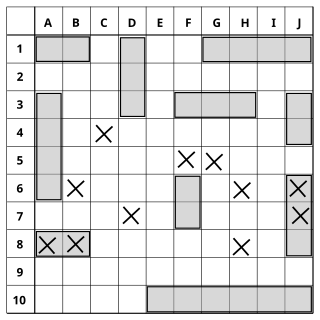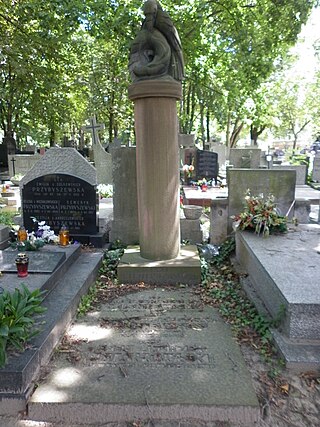
A chessboard is a gameboard used to play chess. It consists of 64 squares, 8 rows by 8 columns, on which the chess pieces are placed. It is square in shape and uses two colours of squares, one light and one dark, in a chequered pattern. During play, the board is oriented such that each player's near-right corner square is a light square.

A crossword is a word puzzle that usually takes the form of a square or a rectangular grid of white- and black-shaded squares. The goal is to fill the white squares with letters, forming words or phrases, by solving clues, which lead to the answers. In languages that are written left-to-right, the answer words and phrases are placed in the grid from left to right ("across") and from top to bottom ("down"). The shaded squares are used to separate the words or phrases.

Battleship is a strategy type guessing game for two players. It is played on ruled grids on which each player's fleet of warships are marked. The locations of the fleets are concealed from the other player. Players alternate turns calling "shots" at the other player's ships, and the objective of the game is to destroy the opposing player's fleet.

Nonograms, also known as Hanjie, Paint by Numbers, Picross, Griddlers, and Pic-a-Pix, and by various other names, are picture logic puzzles in which cells in a grid must be colored or left blank according to numbers at the side of the grid to reveal a hidden pixel art-like picture. In this puzzle type, the numbers are a form of discrete tomography that measures how many unbroken lines of filled-in squares there are in any given row or column. For example, a clue of "4 8 3" would mean there are sets of four, eight, and three filled squares, in that order, with at least one blank square between successive sets.
Lights Out is an electronic game released by Tiger Electronics in 1995. The game consists of a 5 by 5 grid of lights. When the game starts, a random number or a stored pattern of these lights is switched on. Pressing any of the lights will toggle it and the adjacent lights. The goal of the puzzle is to switch all the lights off, preferably in as few button presses as possible.

Sudoku is a logic-based, combinatorial number-placement puzzle. In classic Sudoku, the objective is to fill a 9 × 9 grid with digits so that each column, each row, and each of the nine 3 × 3 subgrids that compose the grid contain all of the digits from 1 to 9. The puzzle setter provides a partially completed grid, which for a well-posed puzzle has a single solution.

Monte Carlo is a pair-matching patience card game where the object is to remove pairs from the tableau. Despite its name, it has no relation to the city with the same name nor to any casino-related game. Alternative names for this game include Good Neighbors and Weddings.
The Game of the Amazons is a two-player abstract strategy game invented in 1988 by Walter Zamkauskas of Argentina. The game is played by moving pieces and blocking the opponents from squares, and the last player able to move is the winner. It is a member of the territorial game family, a distant relative of Go and chess.

Napoleon at St Helena is a 2-deck patience or solitaire card game for one player. It is quite difficult to win, and luck-of-the-draw is a significant factor. The Emperor Napoleon often played patience during his final exile to the island of St Helena, and this is said to be the version he probably played. Along with its variants, it is one of the most popular two-deck patiences or solitaires. The winning chances have been estimated as 1 in 10 games, with success typically dependent on the player's ability to clear one or more columns. The game is the progenitor of a large family of similar games, mostly with variations designed to make it easier to get out.

Poker Squares is a patience game with the objective of building the best poker hands using just 25 cards from the deck. It rewards both lucky guessing and accurate calculation of odds.

Mario's Picross is a 1995 puzzle video game for the Game Boy. Developed by Jupiter and Ape and published by Nintendo, it is a compilation of nonogram logic puzzles. The game stars Mario who chisels away at puzzle grids to form pictures. The game initially received positive reviews, with reviewers citing its length and addictive nature as a positive, but its grid sizes and absence of typical Mario elements as a negative.
GAMES World of Puzzles is a puzzle magazine formed from the merger of Games and World of Puzzles in October 2014.
Hoyle's Official Book of Games is a series of games developed and published by Sierra On-Line. Volume 1, released in 1989, featured multi-player card games. Volume 2, released in 1990, featured 28 varieties of Solitaire. Volume 3, released in 1991, featured board games. Volume 4, was a remake of Volume 1, with two additional games. Sierra continued to publish more games to the series up to its demise. Encore Software has continued publishing entries to the series since then. According to Hoyle 1, it was essentially a spiritual sequel to Sierra's Hi-Res Cribbage (1981).

This is a glossary of Sudoku terms and jargon. It is organized thematically, with links to references and example usage provided as ([1]). Sudoku with a 9×9 grid is assumed, unless otherwise noted.
Cribbage Squares, occasionally Cribbage Square, is a patience or card solitaire based on Cribbage which can be played using a deck of playing cards. This game works the same way as Poker Squares, but with cribbage scoring.

Chuzzle is a tile-matching puzzle video game developed by American studio Raptisoft Games, and published by PopCap Games. The game involves connecting three or more fuzzballs named Chuzzles.
KenKen and KenDoku are trademarked names for a style of arithmetic and logic puzzle invented in 2004 by Japanese math teacher Tetsuya Miyamoto, who intended the puzzles to be an instruction-free method of training the brain. The name derives from the Japanese word for cleverness. The names Calcudoku and Mathdoku are sometimes used by those who do not have the rights to use the KenKen or KenDoku trademarks.

Zillions of Games is a commercial general game playing system developed by Jeff Mallett and Mark Lefler in 1998. The game rules are specified with S-expressions, Zillions rule language. It was designed to handle mostly abstract strategy board games or puzzles. After parsing the rules of the game, the system's artificial intelligence can automatically play one or more players. It treats puzzles as solitaire games and its AI can be used to solve them.

Lech Andrzej Pijanowski was a Polish film critic, broadcaster, director, screenwriter and populiser of games.

Microsoft Entertainment Pack, also known as Windows Entertainment Pack or simply WEP, is a collection of 16-bit casual computer games for Windows. There were four Entertainment Packs released between 1990 and 1992. These games were somewhat unusual for the time, in that they would not run under MS-DOS. In 1994, a compilation of the previous four Entertainment Packs were released called The Best of Microsoft Entertainment Pack. A Game Boy Color version was released in 2000.













